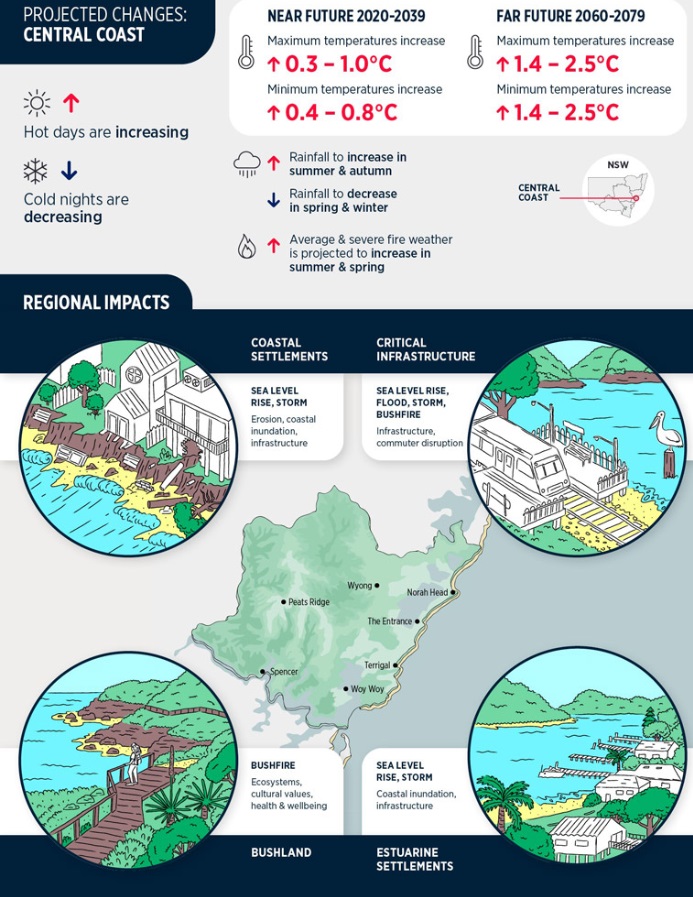Climate change is one of the most significant issues that will impact the lives of people in NSW now and into the future, the Independent Pricing and Regulatory Tribunal (IPART) said this month.
The Central Coast is expected to experience an increase in average, maximum and minimum temperatures for the near future and the far future, based on a 2020 report from the State Government’s Adapt NSW.
“The long-term temperature trend indicates that temperatures on the Central Coast have been increasing since about 1960, with the largest increase in temperatures in the most recent decades,” Adapt NSW stated in a snapshot of the coast.
It said that temperature was the most reliable indicator of climate change.
“Across the Central Coast all of the models agree that average, maximum and minimum temperatures are increasing,” Adapt NSW stated.
And now IPART has identified three main categories and five types of costs councils might have to meet and says it is reasonable for ratepayers to share the costs to address climate change.
“Councils play a vital role in responding and adapting to climate change including natural disasters with the costs of mitigating and adapting likely to be substantial and with a high degree of variation,” IPART stated in its review of the rate peg methodology, released on November 9 (see separate story).
Climate change came up as an external cost that councils are expecting to have to meet.
“Government grants to councils meet some of these climate change costs such as emissions reduction projects, and natural disaster recovery,” IPART stated in the review.
“As ratepayers and the community benefit from councils being able to provide resilient and safe services, it is reasonable for rates to also meet some of these costs.”
IPART identified mitigation, adaptation and natural disaster planning and response as the three new areas requiring new spending.

Higher temperatures would bring: increased demand for reducing urban heat island effect (for example by planting more vegetation); increased stormwater pipe breakages (from tree roots seeking water due to low soil moisture causing pipe breakages); increased need to retrofit buildings, facilities, playgrounds; increased costs to maintain public spaces, gardens; and increased water use.
Heatwaves would bring: increased energy use for cooling systems and water use; increased costs to provide more shade; increased demand for health services; increased risks of power failure increasing the need for alternative power sources; and increased health risks for employees who work outside.
Increasing frequency of bushfires would bring: increased demand for safe places, refuges and evacuation centres; increased demand for fire and emergency response services; increased demand for support services including health services; increased need to protect buildings from fire and reduce fire hazards (maintenance of vegetation); closure of council assets (e.g. parks) and potential loss of revenue (e.g. parking fees); increased restoration and repair of assets affected by fire, replacing damaged signs; increased clean-ups and waste removal; delays or increased difficulty for ratepayers to pay their rates; and increased demand for programs to address vulnerability due to household disruptions.
Changes in rainfall could mean: increased demand for services to deal with increased water-borne diseases and pests; increased damage to roads, increased potholes and need for increased maintenance for kerb and gutter; and delays to maintenance and service schedules (increased wet weather means delays to servicing parks).
Sea level rise, coastal erosion and inundation would: increase demand for coastal protection such as building a sea wall: increase demand for increased maintenance of existing sea walls; increase costs to protect against erosion; and increase demand for levees and maintenance.
Frequency and intensity of extreme storms (winds and hail) issues included: increased repair or replacement of assets affected by storms/hail damage; increased drainage capacity issues and need for new stormwater infrastructure; increased clean-ups and waste removal; increased costs to maintain parks, cemeteries and other open and public spaces; and increased incidences of ratepayer property issues such as removal of heavy fallen branches.
IPART identified new costs because of climate change.
“These reflect costs that are in addition to those related to the delivery of existing services and emerging because of climate change,” IPART said.
“These may depend on a council’s choices about adaptation which could include changes to how services are provided.”
Possible costs included: building new buildings and infrastructure to manage impacts of climate change such as safety refuges, a sea wall or flood levees; raising a dam wall; increasing tree canopy; community education programs to drive behavioural change; research and development; costs to improve planning processes to include climate change (result in higher wages for climate skilled staff); and installing heat sensors.
Climate change is only one of a number of external costs that affect councils.
Others included: the impact on operational costs and depreciation that emerge from infrastructure that may be gifted or transferred to councils; providing community facilities as these are not funded by developer contributions; and cyber security.
IPART recommended that the NSW Government commission an independent investigation of the financial model for councils.
Merilyn Vale


